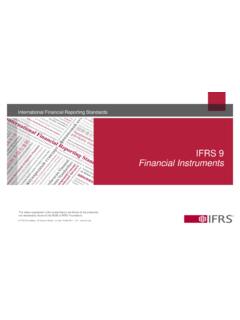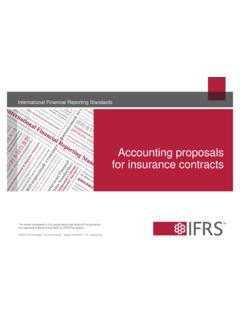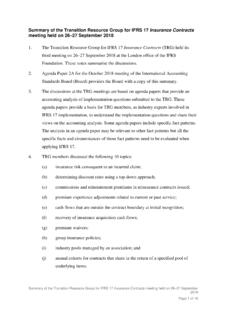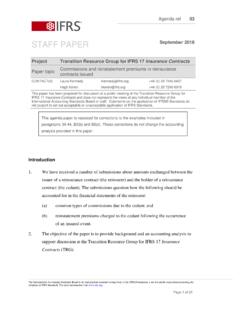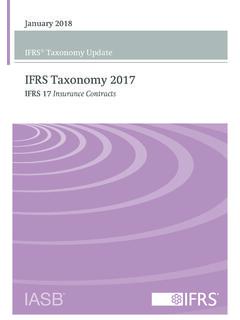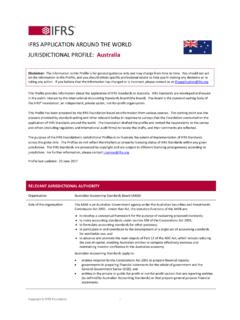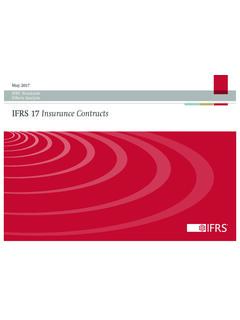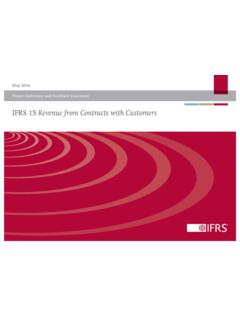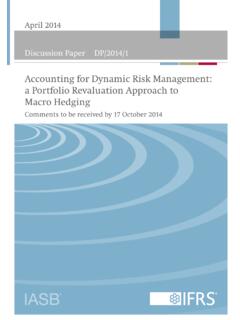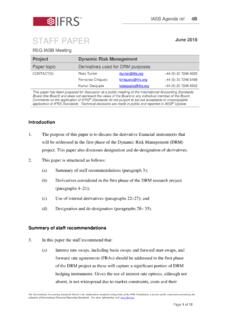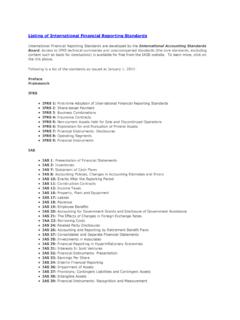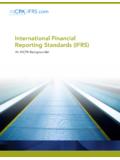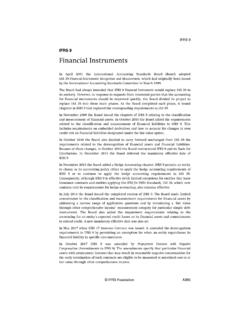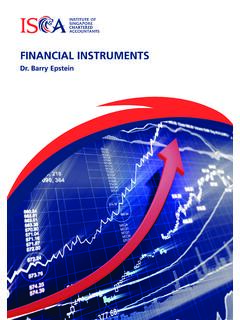Transcription of Education Illustrative examples to accompany IFRS 13 Fair ...
1 EducationDecember 2012 (updated in February 2013)Unquoted equity instruments within the scope of ifrs 9 financial InstrumentsIllustrative examples to accompanyIFRS 13 Fair Value MeasurementEducational material onfair value measurementMeasuring the fair value of unquotedequity instruments within the scope ofIFRS 9 financial InstrumentsThe chapter Measuring the fair value of unquoted equity instruments within the scope of ifrs 9 financial instruments is issued by the ifrs Foundation, 30 Cannon Street, LondonEC4M 6XH, United No: FC023235 Tel: +44 (0)20 7246 6410 Fax: +44 (0)20 7246 6411 Email: ifrs Foundation, the authors and the publishers do not accept any responsibility forany loss caused by acting or refraining from acting in reliance on the material in thispublication, whether such loss is caused by negligence or 2012 ifrs Foundation This version published in 2013 International financial Reporting Standards (including International Accounting Standardsand SIC and IFRIC Interpretations), Exposure Drafts, and other IASB and/or ifrs Foundationpublications are copyright of the ifrs Foundation.
2 Please address publications andcopyright matters to: ifrs Foundation Publications Department,1st Floor, 30 Cannon Street, London, EC4M 6XH, United : +44 (0)20 7332 2730 Fax: +44 (0)20 7332 2749 Email: Web: rights reserved. No part of this publication may be translated, reprinted or reproducedor utilised in any form either in whole or in part or by any electronic, mechanical or othermeans, now known or hereafter invented, including photocopying and recording, or in anyinformation storage and retrieval system, without prior permission in writing from theIFRS ifrs Foundation logo/the IASB logo/ Hexagon Device , ifrs Foundation , eIFRS , IAS , IASB , IASC Foundation , IASCF , ifrs for SMEs , IASs , IFRIC , ifrs , IFRSs , InternationalAccounting Standards.
3 International financial Reporting Standards and SIC are TradeMarks of the ifrs educational material has been prepared by the ifrs Foundation Education Initiativeand has not been approved by the will this chapter assist?5 SCOPE6 THE PROCESS OF PERFORMING FAIR VALUE MEASUREMENTS6 Measuring unquoted equity instruments at fair value6 APPROACHES TO VALUATION8 Market approach11 Transaction price paid for an identical instrument of an investee11 Transaction price paid for a similar instrument of an investee13 Comparable company valuation multiples15 Income approach34 Discounted cash flow (DCF) method35 Other income approach methods55 Adjusted net asset method58 COMMON OVERSIGHTS61 Market approach (comparable company valuation multiples)61 Income approach (DCF method)
4 62 Adjusted net asset method63 GLOSSARY OF TERMS64 ADDITIONAL SOURCES OF INFORMATION69 EDUCATIONALMATERIAL ONFAIRVALUEMEASUREMENT ifrs Foundation3 This educational material accompanies, but is not part of, ifrs 13. It illustrates aspectsof ifrs 13 but is not intended to provide interpretative chapter describes, at a high level, the thought process for measuring thefair value1of individualunquoted equity instrumentsthat constitute anon-controllinginterestin a private company (ie the investee) within the scope of ifrs 9 FinancialInstruments,2in accordance with the principles set out in ifrs 13 Fair chapter presents a range of commonly used valuation techniques formeasuring the fair value of unquoted equity instruments within themarketandincome approaches, as well as theadjusted net asset method.
5 This chapter does notprescribe the use of a specific valuation technique, but instead encourages theuse of professional judgement and the consideration of all facts andcircumstances surrounding the measurement. The particular characteristics ofthe unquoted equity instruments of an investee and the information that isreasonably available to an entity (ie the investor) are two of the factors that theinvestor will need to consider when selecting the most appropriate valuationtechnique. For example, the availability of information aboutcomparablecompany peersin the complete absence of any information about theexpected cashflowstream of an investee might lead an investor to select thecomparable companyvaluation multiples techniquerather than thediscounted cash flow (DCF) , if the investee pays dividends an investor with limited financialinformation might consider using valuation techniques based ondividenddiscount models (DDM).
6 3An entity can comply with the measurement objective in ifrs 13even whenlimited information is available. Although an ownership interest in anotherentity presumes the availability of some financial and other information aboutthe investee, including publicly available information, it is occasionally the casethat such information is incomplete or out of date. This chapter includesexamples that illustrate how, despite an investor having limited financialinformation, the fair value of an unquoted equity instrument can neverthelessbe measured by applying the valuation techniques the development of ifrs 13, the International Accounting StandardsBoard (IASB) was made aware that entities in emerging and transition economieshad concerns about applying the fair value measurement principles in their1 Terms defined in the glossary of this chapter are italicised the first time they appear.
7 This does notinclude publication If an entity does not apply ifrs 9, any reference to ifrs 9 must be read as a reference toIAS 39 financial instruments : Recognition and ONFAIRVALUEMEASUREMENT ifrs , the IASB noted that the concerns raised were notspecific to entities in emerging and transition economies. The lack of marketdata or other key information necessary to perform fair value measurements is aglobal constraint, rather than a regional one. This is why the IASB decided todevelop educational material on fair value measurement for an audience thatincludes not only entities in emerging and transition economies but also entitiesin developed undertake this task, the IASB asked the ifrs Foundation Education Initiativeto develop educational material on fair value measurement that describes, at ahigh level, the thought process for measuring assets, liabilities and an entity sown equity instruments at fair value that is consistent with the objective of afair value measurement set out in ifrs 13.
8 The ifrs Foundation received inputfrom financial Accounting Standards Board (FASB) staff and from a group ofvaluation specialists who measure fair value in developed, emerging andtransition economies. The ifrs Foundation thanks these people for theirassistance in this educational material is structured to address the application of theprinciples in ifrs 13 on different topics in individual chapters. These chapterswill be published as they are finalised. This chapter is published by theIFRS Foundation. Its content isnon-authoritativeand has not been approvedby the chapter illustrates, at a high level, the application of valuation techniqueswithin the context of financial reporting and, more specifically, within thecontext of ifrs 13.
9 It does not aim to provide comprehensive valuation guidanceand, as a result, it does not describe all the substantial work that a valuationexercise might entail in practice. This chapter includes examples that seek onlyto illustrate in a simplified manner the valuation techniques , the examples included in this chapter do not describe all theprocedures and complexities that a valuation exercise might entail in examples also do not stipulate the use of a specific valuation technique inparticular circumstances and, as a result, other techniques might also will this chapter assist?8 This chapter provides high level valuation guidance to support the personnelresponsible for measuring fair value within their organisations when measuringthe fair value of unquoted equity instruments of an investee within the scope ofIFRS 9.
10 Nevertheless, it is expected that, such personnel will have anunderstanding of basic valuation concepts, even if they are not A summary of the concerns can be found in the Basis for Conclusions accompanying ifrs 13 (seeparagraph BC231).EDUCATIONALMATERIAL ONFAIRVALUEMEASUREMENT ifrs Foundation59 Valuations vary in complexity depending on the nature of the underlying assetor liability and the availability of information. This chapter might not becomprehensive enough to support non-valuation specialists performingcomplex valuations for financial reporting purposes or to assist them withassessing whether complex valuations performed by valuation specialists havebeen made in accordance with the principles in ifrs 9 requires entities to measure all investments in equity instruments at fairvalue, even if those instruments are not quoted in anactive market.
